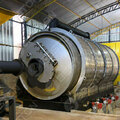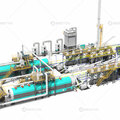Oil sludge, a hazardous byproduct of the petroleum industry, poses significant environmental challenges due to its high levels of hydrocarbons, heavy metals, and other contaminants. Traditional disposal methods, such as landfilling or incineration, can exacerbate pollution and contribute to soil and water contamination. However, advancements in pyrolysis technology offer a promising solution for mitigating oil pollution by converting oil sludge into valuable products while minimizing environmental impact. In this comprehensive guide, we explore the principles of pyrolysis of oil sludge, its environmental benefits, and its role in alleviating oil pollution.
Understanding Oil Sludge
Oil sludge is a semi-solid waste generated during oil exploration, production, refining, and transportation processes. It consists of a complex mixture of hydrocarbons, water, solids, and other impurities, including heavy metals, organic compounds, and inorganic residues. Oil sludge typically accumulates in storage tanks, pipelines, refinery equipment, and wastewater treatment facilities, posing disposal challenges and environmental risks.
Composition of Oil Sludge
The composition of oil sludge varies depending on the source, processing methods, and environmental factors. However, typical components of oil sludge include:
- Hydrocarbons: Petroleum fractions ranging from light oils to heavy bitumen.
- Water: Contaminated water from oil production and processing operations.
- Solids: Inorganic particles, such as sand, clay, and rust, along with organic residues.
- Heavy Metals: Toxic elements, including lead, mercury, cadmium, and chromium, derived from catalysts and additives.
The heterogeneous nature of oil sludge presents challenges for effective treatment and disposal, requiring innovative solutions to minimize environmental impact and resource waste.
Pyrolysis of Oil Sludge: Principles and Process
Pyrolysis is a thermochemical decomposition process that converts organic materials into valuable products in the absence of oxygen. In the context of oil sludge treatment, pyrolysis offers a sustainable and environmentally friendly method for transforming hazardous waste into useful resources. The pyrolysis of oil sludge involves several stages, each characterized by distinct physical and chemical transformations:
-
Preparation: Oil sludge is collected, pretreated, and prepared for pyrolysis, including dewatering, homogenization, and size reduction to improve process efficiency and product quality.
-
Pyrolysis: The prepared oil sludge is subjected to high temperatures (typically between 300°C and 800°C) in a controlled environment, such as a pyrolysis reactor or furnace. During pyrolysis, organic compounds in the oil sludge undergo thermal decomposition, yielding gaseous, liquid, and solid products.
-
Product Recovery: The products of oil sludge pyrolysis include:
- Pyrolysis Gas: A mixture of hydrocarbons, hydrogen, carbon monoxide, and other volatile compounds, which can be used as fuel or feedstock for chemical processes.
- Pyrolysis Oil: A liquid fraction consisting of hydrocarbons, phenols, and other organic compounds, suitable for fuel production or further refining.
- Char: A solid residue rich in carbonaceous material, minerals, and ash, which can be utilized as a soil amendment, carbon source, or industrial filler.
-
Post-processing: The pyrolysis products may undergo additional processing steps, such as filtration, distillation, and purification, to refine their properties and enhance their market value.

Environmental Benefits of Oil Sludge Pyrolysis
Oil sludge pyrolysis offers several environmental benefits compared to conventional disposal methods, including:
- Pollution Prevention: Pyrolysis reduces the volume and toxicity of oil sludge, minimizing the risk of soil and water contamination from hazardous substances.
- Resource Recovery: Pyrolysis converts oil sludge into valuable products, including energy-rich gases, liquid fuels, and carbonaceous char, thereby recovering resources and reducing dependence on fossil fuels.
- Greenhouse Gas Mitigation: Pyrolysis mitigates greenhouse gas emissions by sequestering carbon in the char and converting organic compounds into energy products, displacing fossil fuel consumption and reducing net emissions.
- Land Remediation: Pyrolysis char can be used to remediate contaminated soils, immobilize heavy metals, and improve soil fertility, contributing to sustainable land management and ecosystem restoration.
Applications of Pyrolysis-derived Products
The products of oil sludge pyrolysis have diverse applications across various industries, including:
- Energy Generation: Pyrolysis gas and oil can be used as alternative fuels for power generation, heating, and industrial processes, reducing reliance on conventional fossil fuels and lowering carbon emissions.
- Chemical Manufacturing: Pyrolysis-derived chemicals and intermediates can serve as feedstocks for the production of plastics, resins, solvents, and specialty chemicals, supporting the transition to a circular economy and renewable resources.
- Agricultural and Environmental Remediation: Pyrolysis char can be applied as a soil amendment, biochar fertilizer, or adsorbent for wastewater treatment, enhancing soil health, water quality, and environmental sustainability.
Challenges and Considerations
Despite its environmental and economic potential, the widespread adoption of oil sludge pyrolysis faces several challenges and considerations, including:
- Technology Scalability: Scaling up pyrolysis processes from laboratory or pilot scale to commercial production may require significant investments in equipment, infrastructure, and operational optimization.
- Regulatory Compliance: Compliance with environmental regulations, waste management standards, and health and safety requirements is essential for ensuring the safe and responsible operation of pyrolysis facilities.
- Resource Availability: The availability and accessibility of suitable feedstocks, such as oil sludge, may vary depending on regional factors, industrial activities, and waste management practices.
- Market Demand: The market demand for pyrolysis-derived products, including fuels, chemicals, and soil amendments, may fluctuate based on economic conditions, technological advancements, and consumer preferences.
Future Directions and Opportunities
As environmental concerns and resource constraints drive the demand for sustainable waste management solutions, the field of oil sludge pyrolysis continues to evolve, offering new opportunities for innovation and collaboration. Future directions and opportunities in oil sludge pyrolysis include:
- Technological Advancements: Research and development efforts focused on improving pyrolysis processes, enhancing product yields and quality, and reducing energy consumption and emissions.
- Integrated Solutions: Integration of pyrolysis with complementary technologies, such as bioremediation, wastewater treatment, and renewable energy production, to create synergistic and holistic waste management solutions.
- Policy Support: Policy incentives, regulatory frameworks, and market mechanisms that promote the adoption of pyrolysis technologies and incentivize investment in sustainable waste management practices.
- Public Awareness: Education, outreach, and communication initiatives to raise awareness about the environmental benefits, economic opportunities, and societal implications of oil sludge pyrolysis among stakeholders, policymakers, and the general public.
Conclusion
In conclusion, oil sludge pyrolysis technology offers a promising solution for alleviating oil pollution and addressing the environmental challenges associated with oil sludge disposal. By converting oil sludge into valuable products, such as fuels, chemicals, and soil amendments, pyrolysis mitigates pollution, recovers resources, and promotes sustainable waste management practices. With continued innovation, investment, and collaboration, oil sludge pyrolysis has the potential to play a significant role in advancing environmental stewardship, circular economy principles, and climate resilience in the petroleum industry and beyond.





